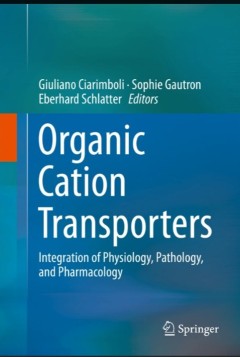Filter by

The Theory of Extensive Form Games
This book treats extensive form game theory in full generality. It provides a framework that does not rely on any finiteness assumptions at all, yet covers the finite case. The presentation starts by identifying the appropriate concept of a game tree. This concept represents a synthesis of earlier approaches, including the graph-theoretical and the decision-theoretical ones. It then provides a …
- Edition
- -
- ISBN/ISSN
- 978-3-662-49944-3
- Collation
- -
- Series Title
- -
- Call Number
- -

Organic Electronics Materials and Devices
This book is an introductory text for graduate students, researchers in industries, and those who are just beginning to work on organic electronics materials, devices and their applications. The book includes mainly fundamental principles and theories for understanding organic electronics materials and devices, but also provides information about state-of-the-art technologies, applications and …
- Edition
- -
- ISBN/ISSN
- 978-4-431-55654-1
- Collation
- -
- Series Title
- -
- Call Number
- 621.381 ORG

Emerging Therapies in Neurorehabilitation II
This book reports on the latest technological and clinical advances in the field of neurorehabilitation. It is, however, much more than a conventional survey of the state-of-the-art in neurorehabilitation technologies and therapies. It was written on the basis of a week of lively discussions between PhD students and leading research experts during the Summer School on Neurorehabilitation (SSNR2…
- Edition
- -
- ISBN/ISSN
- 978-3-319-24901-8
- Collation
- 19 b/w illustrations, 36 illustrations in colour
- Series Title
- -
- Call Number
- -

The Th2 Type Immune Response in Health and Disease From Host Defense and All…
The type 2 immune response that develops during infectious disease has undergone major paradigm shifts in the last several years as new cell types and pathways have been identified. It is now clear that the type 2 immune response, characterized by elevations in specific cytokines, including IL-4, IL-5 and IL-13, is associated with helminth infections in both humans and mice. This response is co…
- Edition
- -
- ISBN/ISSN
- 978-1-4939-2911-5
- Collation
- -
- Series Title
- -
- Call Number
- -

The Testing and Learning Revolution The Future of Assessment in Education
Gordon shows how we can use assessment to support teaching and develop students' competencies. Between 2011 and 2013, Gordon chaired an interdisciplinary commission of scholars and thinkers, who connected transformative research and ideas on learning, teaching, measurement, the nature of tests, intelligence, capability, technology, and policy.
- Edition
- -
- ISBN/ISSN
- 978-1-137-51996-2
- Collation
- -
- Series Title
- -
- Call Number
- -

Emerging Technologies for STEAM Education Full STEAM Ahead
This theory-to-practice guide offers leading-edge ideas for wide-scale curriculum reform in sciences, technology, engineering, the arts, and mathematics--the STEAM subjects. Chapters emphasize the critical importance of current and emerging digital technologies in bringing STEM education up to speed and implementing changes to curricula at the classroom level. Of particular interest are the div…
- Edition
- -
- ISBN/ISSN
- 978-3-319-02573-5
- Collation
- 19 b/w illustrations, 17 illustrations in colour
- Series Title
- -
- Call Number
- -

More Playful User Interfaces
This book covers the latest advances in playful user interfaces – interfaces that invite social and physical interaction. These new developments include the use of audio, visual, tactile and physiological sensors to monitor, provide feedback and anticipate the behavior of human users. The decreasing cost of sensor and actuator technology makes it possible to integrate physical behavior inform…
- Edition
- 1
- ISBN/ISSN
- 978-981-287-546-4
- Collation
- -
- Series Title
- Gaming Media and Social Effects
- Call Number
- -

The Teaching and Learning of Statistics International Perspectives
This book presents the breadth and diversity of empirical and practical work done on statistics education around the world. A wide range of methods are used to respond to the research questions that form it's base. Case studies of single students or teachers aimed at understanding reasoning processes, large-scale experimental studies attempting to generalize trends in the teaching and learning …
- Edition
- -
- ISBN/ISSN
- 978-3-319-23470-0
- Collation
- -
- Series Title
- -
- Call Number
- -

Organic Cation Transporters : Integration of Physiology, Pathology, and Pharm…
This innovative text explores the cellular transport of organic cations, from functional and structural properties to pharmacological implications and psychiatric developments. The authoritative chapters introduce organic cation transporters and then proceed to discuss their mechanisms such as binding of substrates and inhibitors; their drug dispositions and toxicity; their relationships to gen…
- Edition
- -
- ISBN/ISSN
- 978-3-319-23793-0
- Collation
- -
- Series Title
- -
- Call Number
- 541.372 ORG

The Teaching Profession Present and Future
This volume contributes to debates about the teaching profession by reviewing international and national reports on its status, as well as on reforms of various education systems. It proposes a global approach to the quality of the teaching profession as a decisive ingredient of education quality, including a conception of its identity and a vision of its future. Moreover, it is suggested that …
- Edition
- -
- ISBN/ISSN
- 978-3-319-12130-7
- Collation
- -
- Series Title
- -
- Call Number
- -
 Computer Science, Information & General Works
Computer Science, Information & General Works  Philosophy & Psychology
Philosophy & Psychology  Religion
Religion  Social Sciences
Social Sciences  Language
Language  Pure Science
Pure Science  Applied Sciences
Applied Sciences  Art & Recreation
Art & Recreation  Literature
Literature  History & Geography
History & Geography